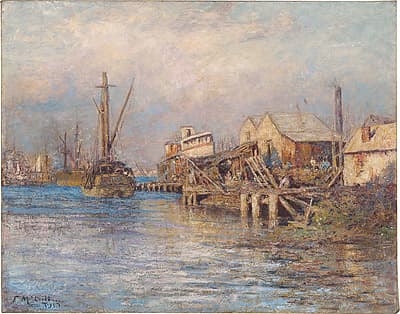Frederick
MCCUBBIN
Australia
1855
–
1917
The old slip, Williamstown
[Williamstown]
1915
oil on canvas
92.0 (h)
x 117.5 (w)
cm
Private collection
Williamstown provided McCubbin with a subject—sea and sky drenched in light—in which he could explore some of the approaches he admired in Turner’s work. The painting depicts a vessel on the slips at Williamstown Patent Slip,
a double-hipped roofed building with a tall chimney and a further building immediately in front. To the side are pier works and timber material.
McCubbin painted The old slip, Williamstown in his studio, working from the small sketches of Williamstown he’d painted on the spot (see cats 22, 24). In composition and light effects this work particularly resembles the rapidly executed watercolour, Williamstown (cat 26). He applied his paint in rapid strokes, richly laden on his brushes and palette knife. In depicting the water and sky in this work, he used a sumptuous range of colours to evoke the twilight hour. He mixed the pigment on the palette, to keep it purer, painting the work in several sessions, dry paint onto dry paint, so the underneath colours could show through and an effect of transparency could be achieved. He appears to have used his fingers to smooth out the sky and clouds and create a sense of airiness.
Soon after his arrival in London in 1907, McCubbin visited the National Gallery. He wrote to his wife on 11 July: ‘and then the Turners, so familiar, the great struggle he had from the dark old [conventions] up to light, culminating in the Glorious Approach to Venice, exactly as we thought it would look and so near to us’ (Mackenzie 1990, p 257). When he visited the Tate, McCubbin wrote to his wife again, of the works by Turner he saw there:
no theatrical effect but mist and cloud and sea and land drenched in light—[There is] no other master like him … these gems with their opal colour—you feel how he gloried in these tender visions of light and air. He worked from darkness into light—His contemporaries could not follow him ... [these works] belong mostly to the same time of the Approach to Venice—Fancy the world taking the greatest period of his Art for madness (ibid, p 259).
The work McCubbin refers to in this letter as Turner’s ‘Approach to Venice’ 1843 is now known as St Benedetto, looking towards Fusina c 1843 (Turner Bequest, Tate). It was regarded by young artists as the epitome of Turner’s late style and was one of his most copied works.
Although dated ‘1915’, The old slip, Williamstown is most likely the painting that was exhibited in the first Australian Art Association exhibition at the Melbourne Athenaeum Hall in 1913, where a critic described it as ‘virile in thought and expressed in romantic language’ (Argus, 7 May 1913, p 5). It would also seem to be the same work as that reproduced in The art of Frederick McCubbin in 1916, although there it appears to be undated, but is given the date of 1909. It could have been wrongly dated in the caption, or this work may be a second version, of which the first is now lost. (McCubbin is known to have revisited his subjects, painting for instance two versions of his backyard: Winter sunlight 1908 (cat 11) and the slightly larger 1916 version, Autumn morning, South Yarra (cat 72)). Alternatively, and most likely, it is quite possible that the painting was signed and dated at a later stage.
The original owner of this work, Emily Constance, was a student of McCubbin’s.
